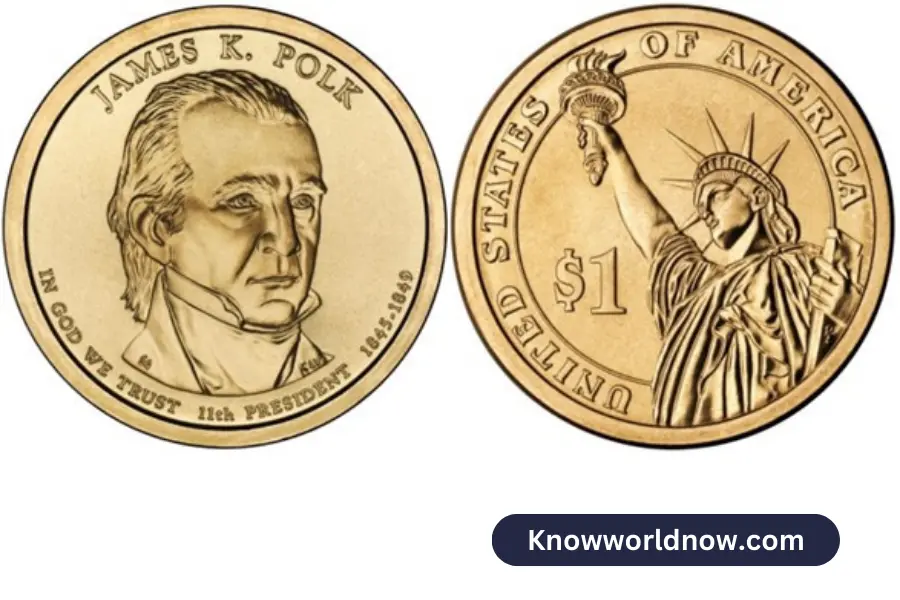President James K. Polk served 6 terms in the U.S. House of Representatives and took office as a Tennessee governor before he became the first Dark Horse candidate to take the presidency in 1845. This made him the 11th President of the United States, and his commemorative dollar coin was the 11th released in August 2009.
The value of the James K. Polk dollar coin is similar to others in the series, and most of the coins sell for $3 without issue. Special proof coins and those with rare errors, as well as those in near-perfect condition, regularly sell for much more if they go to auction.
You should thoroughly evaluate the condition and details of your James K. Polk coin to make sure you don’t undervalue it (or pay too much). This guide explains the general value of these coins as well as what may increase their worth.
How Much is a James K. Polk Dollar Coin Worth?
Unless you find a spectacularly poor or pristine example of the coin, most James K. Polk dollar coins are worth about $3. They’re commemorative coins that were only minted for a season, but a few fell into circulation and weeded themselves out at face value.
| Mint Mark | General Value |
| 2009 P James K. Polk Dollar | $3 to $70 |
| 2009 P James K. Polk Dollar [Special Strike] | $3 to $1,000 |
| 2009 D James K. Polk Dollar | $2 to $350 |
| 2009 D James K. Polk Dollar [Special Strike] | $3 to $500 |
| 2009 S Proof James K. Polk Dollar | $35 |
The upper limit of the James K. Polk dollar value depends on the particular mintage you have and who is willing to buy it. The production was split pretty evenly between the Philadelphia and Denver mints, but coin admirers will pay extra to fill in any gaps in their collections.
2009 P James K. Polk Dollar Coin Value
Philadelphia produced the majority of the James K. Polk dollar coins with 46,620,000 minted in 2009. This included both Position A and Position B Presidential Dollar Coins as well as regular and special strike.
PCGS does a great job of tracking how well each of these varieties does at auction and how that reflects their speculative value. For example, the record holders for the regular strike P James K. Polk dollar coins sold for $34 (Position A) and $14 (Position B).
The Position A satin finish James K. Polk dollar auction record holder brought in $640, which is expected with a special strike. Oddly enough, the highest auction record for Position B only sold for $10.
What’s the Difference Between Position A and B James K. Polk Dollar Coins?
Position A and Position B Presidential Dollar coins aren’t official designations, but they’re important to collectors nonetheless.
The position refers to the orientation of the edge lettering in relation to the orientation of the portrait. The Presidential Dollar Coin series features incused inscriptions of the year, “E PLURIBUS UNUM”, and the mint mark, which is rare for American coinage.
When they were produced, the coins were first stamped on the front and back and dropped into a bin. This bin of coins would feed the incusing machine, but there was no process for positioning the coins a certain way.
Position A refers to those with upside-down edge lettering when the Polk’s portrait is face up. Position B coins have normal edge lettering when Polk’s portrait is face up.
While there’s no official count of each position, it’s assumed the mintages are split 50/50. The orientation is only valuable if a collector is looking for one or the other, but professional grading services usually keep track of this simple detail.
2009 D James K. Polk Dollar Coin Value
A total of 41,720,000 James K. Polk dollar coins were struck at the Denver Mint, making up slightly less than half of the total quantity minted. Unlike some other series, the D James K. Polk dollars carry a slightly lower value than those from the Philadelphia mint.
Auction records include:
- An MS68 Position A that sold for $60 in 2022
- A Position B in the same grade that sold for $14 in 2022
- An SP68 special strike coin that sold for $40 in 2023
- An SP69 in Position B that sold for $329 in 2017
The 2009 James K. Polk dollar struck with a D mark is still found in great condition, and you can expect it to sell for no less than $2.
2009 S Proof James K. Polk Dollar Coin Value
San Francisco struck all 2,809,452 proof versions of the James K. Polk dollar coin in 2009. While the S mark on the edge inscription is a clear giveaway, these coins also feature higher-contrast details and highly-reflective surfaces you won’t see in other strikes.
Most collectors snatch up the proof coins as soon as they go on sale, meaning these coins are more likely to remain unmarred. They regularly sell for more, but also max out around $35 because a high-grade coin isn’t actually that rare.
The auction record for the S proof James K. Polk dollar coin sold for $204 in 2010.
Checking the Value of Your James K. Polk Dollar Coin
It’s okay if you’re still unsure how to value your James K. Polk dollar coin. Details like coin condition are difficult to accurately evaluate, especially when you hit the high grade that these commemorative coins tend to show up in.
This is why collectors and numismatists utilize tools like Coin Value Checker. By updating prices daily and considering every variable, you get an accurate assessment of coin value and can make the most informed decision in your coin-related transactions.
How James K. Polk Dollar Coins are Evaluated
Generally, collectors want coins that are rare and in phenomenal condition. The James K. Polk dollar coin is no exception, but it can be a bit tricky to evaluate.
To start, dollar coins are unlikely to enter circulation in the first place. When you make them even more rare by making a single-run coin (like all of those in the Presidential Dollar Coin series), it’s safe to assume most of those will not end up as pocket change.
This results in a high number of coins in great condition. Because of this, most of the James K. Polk dollar coins are worth a small premium, and the condition-to-value scale only steepens when you reach the very top.
The coin’s mintage is pretty evenly divided as well, even when you consider the different edge inscription positions and the satin finish coins. Apart from the S mark proof coins, the mintage doesn’t seem to have an effect on the ultimate value of the coin.
The biggest wild card is whether you can find a James K. Polk dollar coin with a rare error on it. As long as it’s a verified Mint error (meaning it occurred during production), the value of the coin can easily multiply.
Common Errors on James K. Polk Dollar Coins
Coin condition may have the biggest influence on the baseline value of a James K. Polk dollar coin, but an error is what makes the value spike.
Mint errors aren’t common, but they tend to show up in clutches. This is because they happen as a result of something in the production of the coins, like a machine failure or damaged parts.
Overall, the entire Presidential Dollar Coin series is plagued by errors that relate to the edge inscription. As already seen on the “Position A vs. Position B” situation, the minting process didn’t set the coins up for consistency in this department.
The inscription position isn’t really considered an error unless it happens on a proof coin. Instead, look for:
- Missing edge lettering
- Missing planchet
- Double edge lettering
These errors seem less common in the James K. Polk dollar than the previous coins (likely due to refinement of the process), but they’re not unknown.
Missing Edge Lettering
Most American coins do not have edge lettering, but this would be an error for the James K. Polk dollar. The Presidential Dollar coins missing their edge lettering seem to have skipped the second stage of the minting process, instead heading straight to circulation.
Missing edge lettering occurred most often on the Special Strike Presidential Dollar coins, but PCGS doesn’t recognize any in their database for the James K. Polk coin. They do highlight one with weak edge lettering that sold for $300 in 2019.
Blank Planchet
Alternatively, you may see a James K. Polk dollar coin with blank planchet. These coins somehow missed the first stage of minting but skated through the edge incusing machine anyway.
These are incredibly rare and valuable, and it would be impossible to tell which of the four presidents from 2009 the coin actually represented unless they were caught in the year of production.
One example of this error is an NGC certified 2008 Monroe coin that sold for $20,000 on eBay.
Double Edge Lettering
A James K. Polk dollar coin with double edge lettering would have two sets of the edge inscription. These coins somehow ended up traveling through the incusing machine twice, resulting in overlapping inscriptions.
Again, this is usually seen in the initial Presidential Dollar coins like this double edge John Adams coin that sold for $250.


![Dogecoin Price Prediction 2050 [Updated] 3 Dogecoin price prediction 2050](https://knowworldnow.com/wp-content/uploads/2022/03/Dogecoin-price-prediction-2050.webp)
![SafeMoon Price Prediction 2023, 2025, 2030, 2040, 2050 [Updated] 4 SafeMoon Price Prediction 2023, 2025, 2030, 2040, 2050](https://knowworldnow.com/wp-content/uploads/2022/09/SafeMoon-Price-Prediction-2023-2025-2030-2040-2050.png)

